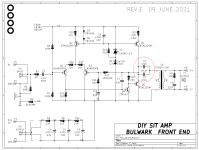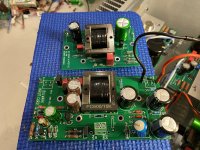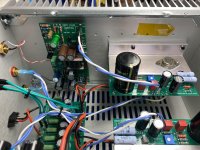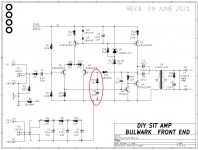Yes, I know, but that is rather expensive. But I will try that anyway, since I have made good experiences with Jensen transformers in the pro-audio domain.
And here is a price quote from DigiKey's DKRed PCB manufacturing service, 5 minutes ago. Quite a bit more money, and longer turnaround!!!
_
I ordered some of your low voltage switch / soft start boards from DKRED as I was getting the parts together. It’s an adventure now a days to source everything. Over the course of a few weeks, I would source something that is out of stock at Mouser, and by the time I confirm that item, Mouser would be out of something else on my cart. At some point I started to wonder if I had messed up the order at DKRED, as I never saw follow up emails from them. The boards eventually shipped many weeks after the order. And, as Mark mentioned, the total price was about the same per board.
The overseas (China) fab operations provide a smoother experience. Faster production times, with steady notifications during the process. Perhaps some of you experts can comment on any quality differences, I sense no deceased quality.
While I am in no time crunch, and I was not ready to build one until I, finally, got all the parts together. I am a Pass “greedy boy”, and sometimes I need a board now.
I haven't ordered PCBs from DKred, but I have ordered boards from eight or ten PCB fabs in China. I found them through the excellent referral website www dot pcbshopper dot com. I've been extremely pleased with the quality, turnaround speed, and price I received from two Chinese fabs in particular: JLCPCB and Elecrow. But everything changes and the best yesterday may not be the best today, so get up-to-the-minute price quotes on pcbshopper dot com and compare for yourself.
I recently manufactured some PCBs with DKRed. Really a mixed experience:
- I ordered the minimum of 4 they require from you, you cannot order less
- the 10 days timeframe are “working days”, so expect a little longer than 2 weeks of wait
- upon shipping, they gave me a tracking number that never moved passed the “label created”
- 4 days later a package arrived with ANOTHER tracking number, so I was not ever notified of a shipping process other than going from “label created” to receiving a package at my door!
- I got 9 PCBs! No idea how or why that happened, perhaps beneath a certain size for them the price is the same so they produce them and ship them nonetheless? Still, I would prefer to pay less and get the 4 than a more expensive service that gives me 9 PCBs.
- I think the quality is pretty good
As far as price goes, I didn’t do a very thorough research, but I think that if you are ordering 10+, other services may be less expensive. For < 10, with free shipping, maybe DKRed is less expensive?
For people in places where more hobbyists live, ordering a higher number and then distributing them internally makes sense. For me, they are just storage space, so ordering north of 10 PCBs doesn’t make much sense, as redistributing them would be more expensive to others than printing anew.
That was my experience,
Rafa.
- I ordered the minimum of 4 they require from you, you cannot order less
- the 10 days timeframe are “working days”, so expect a little longer than 2 weeks of wait
- upon shipping, they gave me a tracking number that never moved passed the “label created”
- 4 days later a package arrived with ANOTHER tracking number, so I was not ever notified of a shipping process other than going from “label created” to receiving a package at my door!
- I got 9 PCBs! No idea how or why that happened, perhaps beneath a certain size for them the price is the same so they produce them and ship them nonetheless? Still, I would prefer to pay less and get the 4 than a more expensive service that gives me 9 PCBs.
- I think the quality is pretty good
As far as price goes, I didn’t do a very thorough research, but I think that if you are ordering 10+, other services may be less expensive. For < 10, with free shipping, maybe DKRed is less expensive?
For people in places where more hobbyists live, ordering a higher number and then distributing them internally makes sense. For me, they are just storage space, so ordering north of 10 PCBs doesn’t make much sense, as redistributing them would be more expensive to others than printing anew.
That was my experience,
Rafa.
Last edited:
It may be a heretical question here, but can I not use the Bulwark circuit ... without the transformer? With higher gain of course. Well, even the gain could be set as high as possible to omit the preamp, or to use a B1 for example.
Ask yourself why the no-transformer front end boards (Marauder and Dreadnought) include a voltage booster circuit "JBOOST1" on their internal power supply , but the front ends with a transformer (NP_JFET, Scourge, Bulwark, Relentless) do not.
It's your board and you can do whatever you want with it. But I am concerned that the 25V rated capacitors C2 and C3 could fail when you try to turn up the volume. Perhaps other members have additional insights, feel free to chime in!
_
It's your board and you can do whatever you want with it. But I am concerned that the 25V rated capacitors C2 and C3 could fail when you try to turn up the volume. Perhaps other members have additional insights, feel free to chime in!
_
Attachments
Last edited:
Yes, there is the question of having sufficient output signal strength. My variation using the Jensen transformers configured for 1:2 gain seems to be working well. I have switched to using a polar capacitor (Elna 47 uF, 35V) in combination with a Wima 0.33 uF polypropylene at the C2 and C3 locations. Installing the polar cap correctly is critical, and happens to be opposite of what the square through hole indicates. The negative (short) lead needs to be inserted into the square outline hole. I also used a polar electrolytic at C10, in this case a Kemet A759 series 220 uF, 63V.
I think it is possible to run the Bulwark circuit at higher voltage, supplied by an small external DC-DC converter module. That would require some very rigorous checking of voltage ratings and bias points. With the Bulwark circuit supplying all the gain (5x to 7x), and no transformer on the output, it is probably necessary to add a small film cap across R22 for a little stability / bandwidth limiting.
Then there is the question of output signal polarity. The N-type VFET amp will be fine taking the positive polarity. The P-type VFET amp will want to invert the output polarity to sound best,
I think it is possible to run the Bulwark circuit at higher voltage, supplied by an small external DC-DC converter module. That would require some very rigorous checking of voltage ratings and bias points. With the Bulwark circuit supplying all the gain (5x to 7x), and no transformer on the output, it is probably necessary to add a small film cap across R22 for a little stability / bandwidth limiting.
Then there is the question of output signal polarity. The N-type VFET amp will be fine taking the positive polarity. The P-type VFET amp will want to invert the output polarity to sound best,
Attachments
Last edited:
Thank you for your comments.
I do not see any necessity for non polarized caps (for feedback and output) anyway. I have made several line amp stages before, with single ended supplies, and non of them are using non-polarized caps. And I do not really see that the output swing from the stage should not be sufficient. And if not, I can always use the lower gain stages and use a dedicated preamp. (I - btw - have the n-version of the Vfet Amp).
I do not see any necessity for non polarized caps (for feedback and output) anyway. I have made several line amp stages before, with single ended supplies, and non of them are using non-polarized caps. And I do not really see that the output swing from the stage should not be sufficient. And if not, I can always use the lower gain stages and use a dedicated preamp. (I - btw - have the n-version of the Vfet Amp).
Do not get me wrong: I do like the transformer version. But I was just thinking about something alternative. And it should work, probably like this: Project 83 - MOSFET Power Follower
Here's a snippet from Nelson Pass's document about VFET part 1 (the initial batch of amps, using Pchannel VFET devices)
Nelson tells us: the gain of the amplifier as a whole, from RCA input jack to 5-way binding post speaker outputs, is 10dB (in red). That's 3.2x.
Since we know the gain of the complementary JFET buffer on the front end card is 0.99x, and we know the gain of the Edcor transformer is 5.0x, it's easy to calculate the gain of the complete front end card: 0.99 * 5.0 = 4.95x.
The gain of the amp as a whole, is just (front end card gain) * (output stage gain). Plugging in the numbers:
4.95 * (output stage gain) = 3.2
Therefore output stage gain = 3.2 / 4.95 = 0.646 (which is -3.8 dB).
Nelson's plot of distortion vs output power, shows the amp is able to deliver about 11 watts into 8 ohms without clipping; that's a voltage swing of 9.38 volts (RMS) at the loudspeaker terminals. To get 9.38 volts of output from the output stage card, we must apply (9.38 / 0.646) = 14.5V (RMS) at the input of the output stage card.
A sine wave whose amplitude is 14.5V RMS, swings from -20.5V at the trough, to +20.5V at the peak. That's what your front end card has to provide, in order to drive the output stage to full output power. A total swing of 41 volts.
You can't get a 41V swing from (+36V, GND) supplies {the Pchannel VFET amp} unless your front end card includes a transformer or a DC to DC converter.
You also can't get a 41V swing from (+34V, GND) supplies {the Nchannel VFET amp with resistors in the supply filter} unless your front end card includes a transformer or a DC to DC converter.
_
Nelson tells us: the gain of the amplifier as a whole, from RCA input jack to 5-way binding post speaker outputs, is 10dB (in red). That's 3.2x.
Since we know the gain of the complementary JFET buffer on the front end card is 0.99x, and we know the gain of the Edcor transformer is 5.0x, it's easy to calculate the gain of the complete front end card: 0.99 * 5.0 = 4.95x.
The gain of the amp as a whole, is just (front end card gain) * (output stage gain). Plugging in the numbers:
4.95 * (output stage gain) = 3.2
Therefore output stage gain = 3.2 / 4.95 = 0.646 (which is -3.8 dB).
Nelson's plot of distortion vs output power, shows the amp is able to deliver about 11 watts into 8 ohms without clipping; that's a voltage swing of 9.38 volts (RMS) at the loudspeaker terminals. To get 9.38 volts of output from the output stage card, we must apply (9.38 / 0.646) = 14.5V (RMS) at the input of the output stage card.
A sine wave whose amplitude is 14.5V RMS, swings from -20.5V at the trough, to +20.5V at the peak. That's what your front end card has to provide, in order to drive the output stage to full output power. A total swing of 41 volts.
You can't get a 41V swing from (+36V, GND) supplies {the Pchannel VFET amp} unless your front end card includes a transformer or a DC to DC converter.
You also can't get a 41V swing from (+34V, GND) supplies {the Nchannel VFET amp with resistors in the supply filter} unless your front end card includes a transformer or a DC to DC converter.
_
Attachments
Yay Mark Johnson! Lots of fun to be had, coming soon to a DIYaudiostore near you. Can't wait to give these a listen.😀
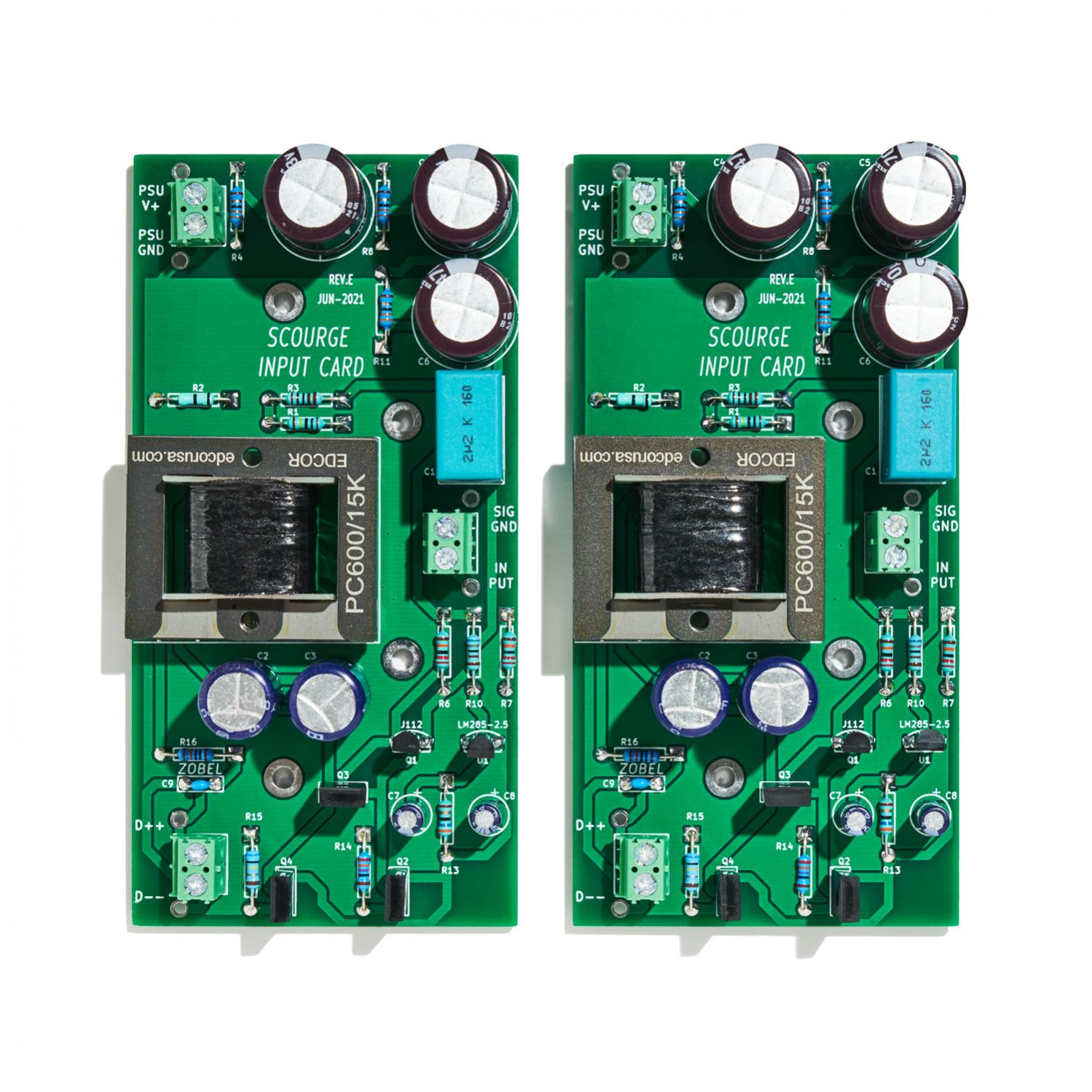
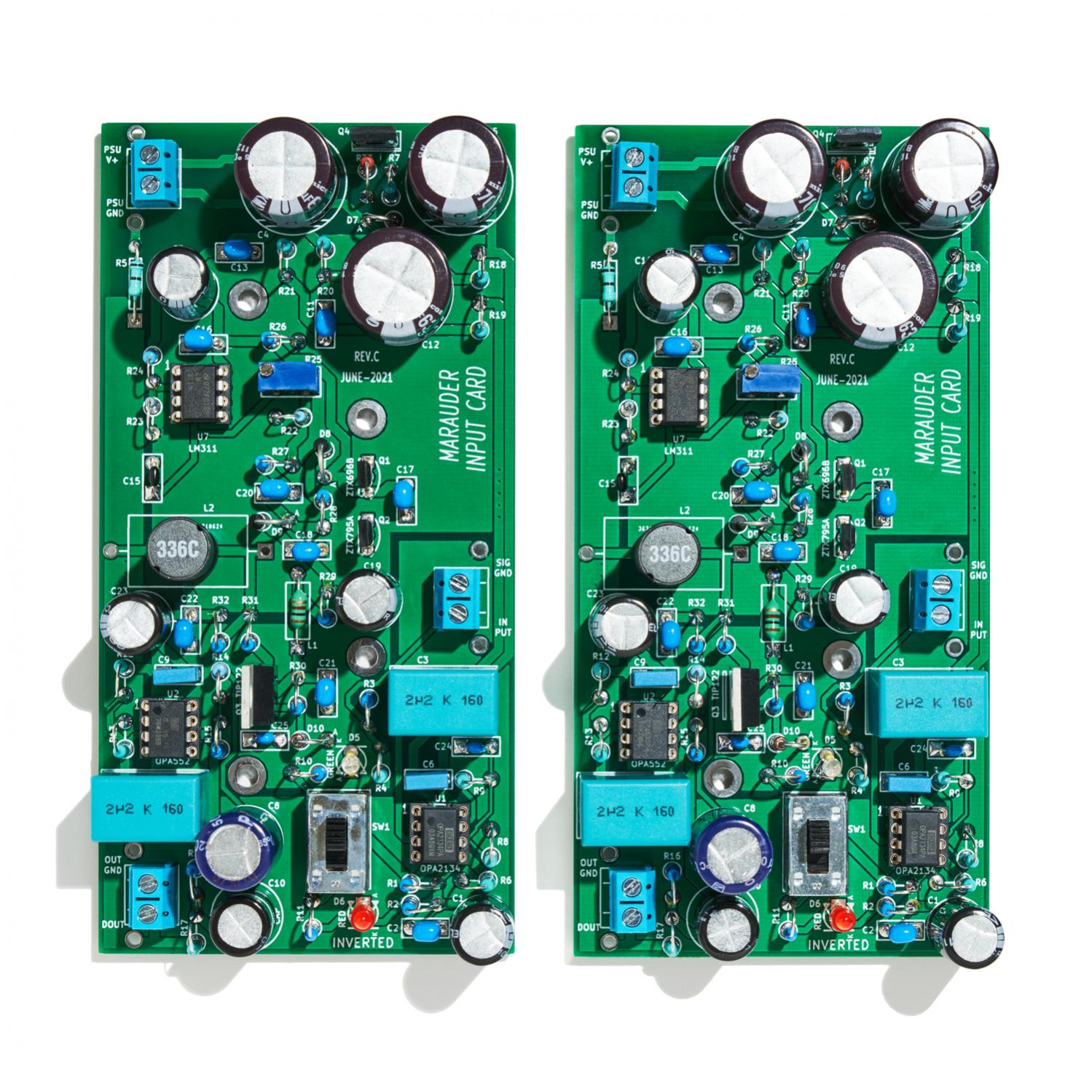
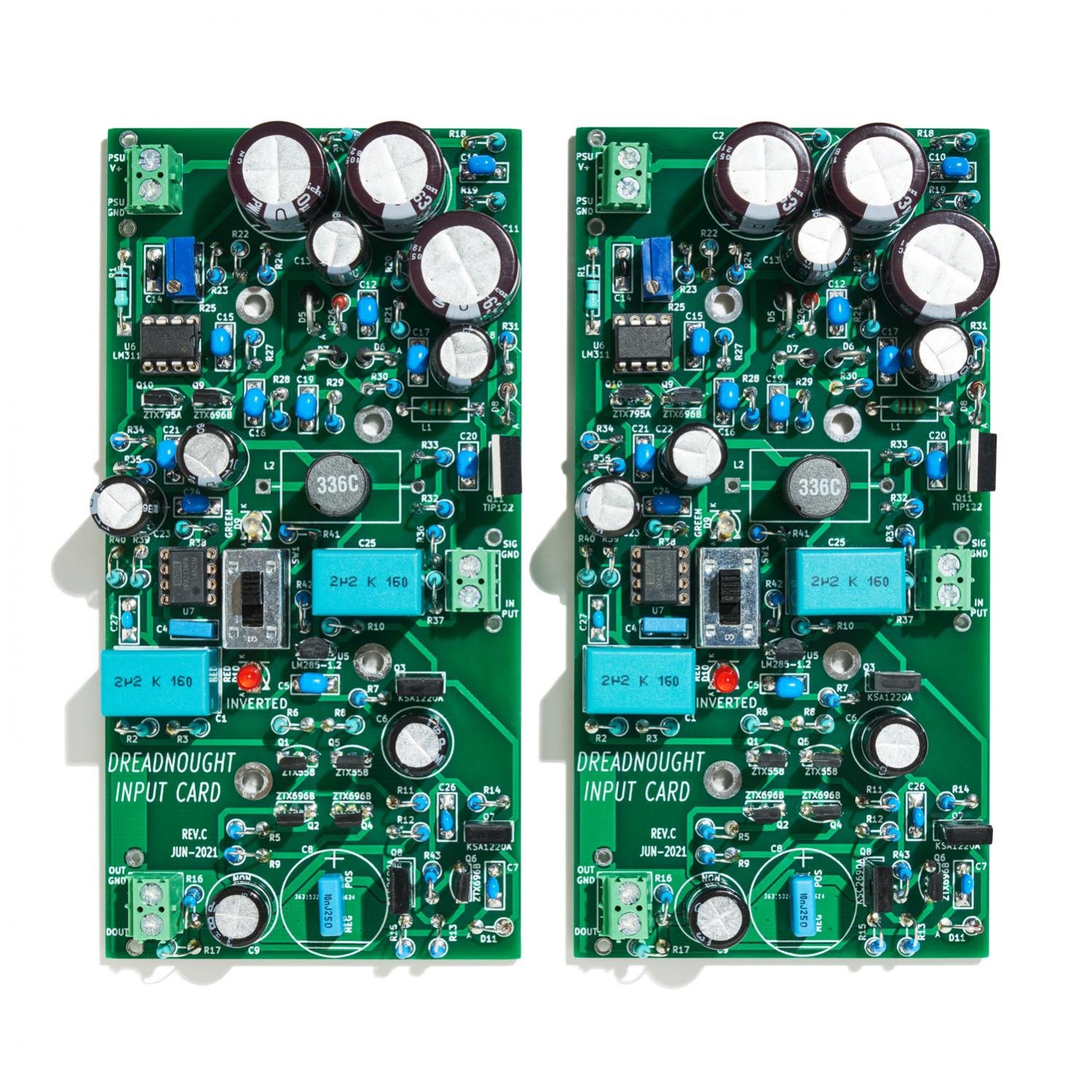
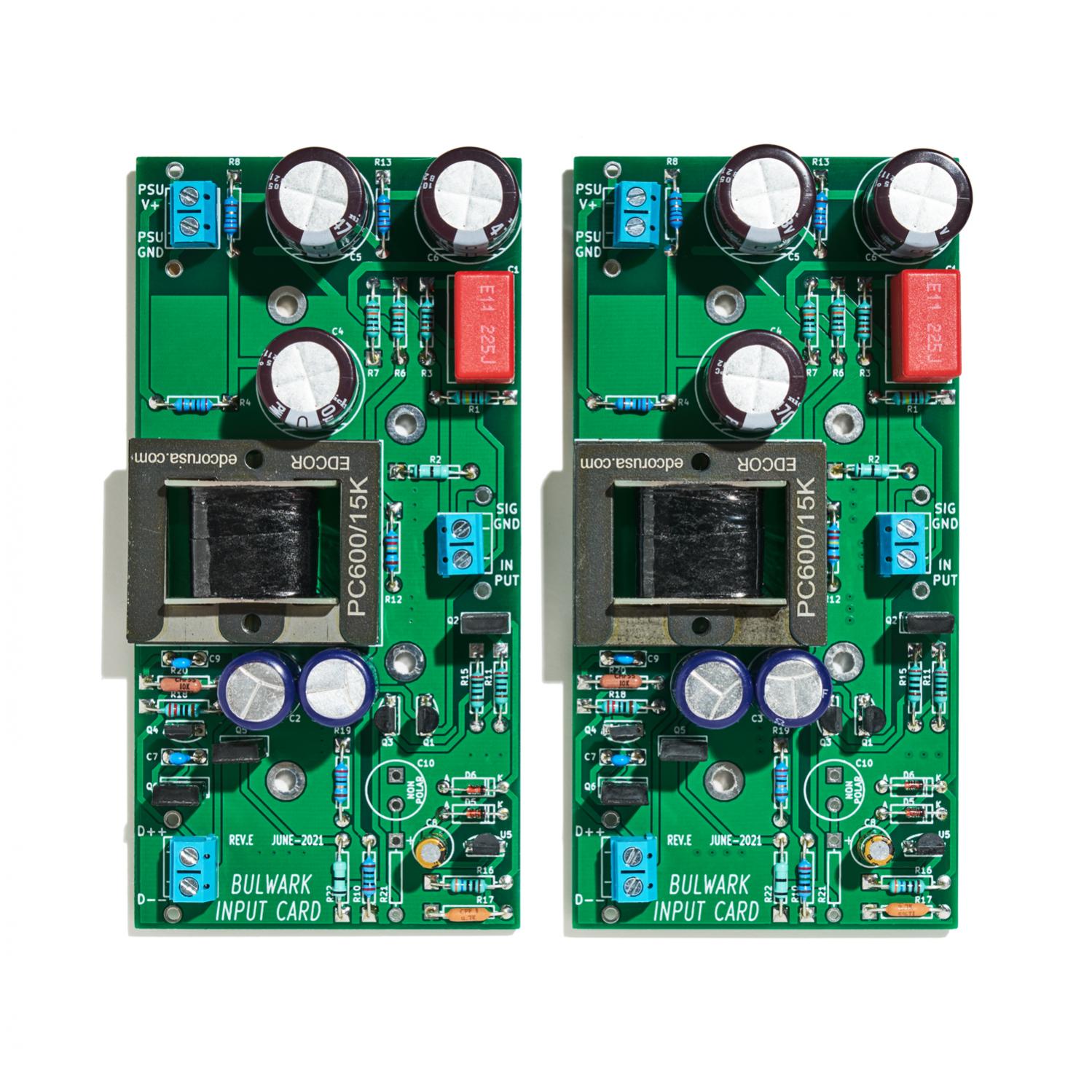
Attachments
-
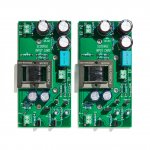 DIY-Audio-10-2021-VFET-Scourge-Assembled@1500px.jpg237.5 KB · Views: 653
DIY-Audio-10-2021-VFET-Scourge-Assembled@1500px.jpg237.5 KB · Views: 653 -
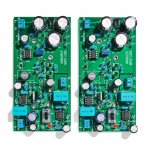 DIY-Audio-10-2021-VFET-Marauder-Assembled@1500px.jpg308.1 KB · Views: 625
DIY-Audio-10-2021-VFET-Marauder-Assembled@1500px.jpg308.1 KB · Views: 625 -
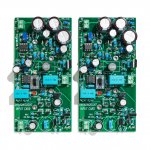 DIY-Audio-10-2021-VFET-Dreadnought-Assembled@1500px.jpg319.1 KB · Views: 629
DIY-Audio-10-2021-VFET-Dreadnought-Assembled@1500px.jpg319.1 KB · Views: 629 -
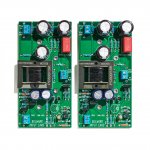 DIY-Audio-10-2021-VFET-Bulwark-Assembled@1500px.jpg256.8 KB · Views: 642
DIY-Audio-10-2021-VFET-Bulwark-Assembled@1500px.jpg256.8 KB · Views: 642
That spectacular craftsmanship was performed upon PCBs and parts kits from the diyAudio Store; kits that will very soon be available for purchase. Excellent job, Patrick!
Hearty congratulations also to Vincent, who created those kits! Astonishingly well done! He managed to source all of those parts in the middle of a severe and global component shortage. That's a huge accomplishment.
And of course big thanks to Nelson Pass, who boldly insisted upon a 41 volt swing (peak to trough) out of front end cards whose supply is only 36 volts. Here now are four of them, two with transformers and two without; available in the diyAudio Store soon.
Hearty congratulations also to Vincent, who created those kits! Astonishingly well done! He managed to source all of those parts in the middle of a severe and global component shortage. That's a huge accomplishment.
And of course big thanks to Nelson Pass, who boldly insisted upon a 41 volt swing (peak to trough) out of front end cards whose supply is only 36 volts. Here now are four of them, two with transformers and two without; available in the diyAudio Store soon.
Quite possibly more fun than we should be allowed to have with Nelson’s VFET amp. 😉
I’ve built the Dreadnought and two flavors of Bulwark – Edcor and Jensen. It’s great to see these arriving at the store.
I’ve built the Dreadnought and two flavors of Bulwark – Edcor and Jensen. It’s great to see these arriving at the store.
Vunce, go ahead and order one of the 140x70 PCBs (Marauder or Dreadnought) and position its bare PCBoard on your heatsink. If wiring needs to be rearranged, do it now. Then when you decide to listen to one of the Big Dog frontends, your amp will be ready and able and willing.
Thanks for the tip Mark. Didn’t realize the Marauder and Dreadnought are approximately 10mm longer and 5mm wider than the others. I have a bit of slack in the wires needed for hook-up, hopefully I’m good to go already. Although, I’m enjoying the Bulwark and don’t have the urge to dig in again……Yet 🙂
Hey, wait a minute! What happened to C10 and R21 on Bulwark?
Did I miss something?? I'm sure I put them in there! 😀
Thanks Mark for the designs. I'm glad this project has finally come to fruition.
Did I miss something?? I'm sure I put them in there! 😀
Thanks Mark for the designs. I'm glad this project has finally come to fruition.
For those who haven't spent 30 hours studying the schematics (as WBS did while he was laboriously sourcing thousands of components and collating hundreds and hundreds of kits) -- HE IS JOKING. But you have to read the Bulwark schematic to understand the joke. See attachment.
On the Bulwark schematic and in the Store kits, C10 and R21 are designated Do Not Stuff / Do Not Solder. They are options which I provided: they give confident, brave and self-sufficient builders an ability to increase the voltage gain of Bulwark, even greater than the 5X gain which the Edcor transformer already provides.
C10 and R21 are not stuffed and soldered on the Bulwark PCBs shown in post #193 . This is correct! C10 and R21 are not included in the kit sold by the Store. This is also correct.
If you really know what you're doing, if you are confident and brave and self-sufficient, please feel free to calculate values for C10 and R21, solder them into your Bulwarks, and experience the result. If you don't really know what you're doing, if you're not confident + brave + self-sufficient, leave them out.
_
On the Bulwark schematic and in the Store kits, C10 and R21 are designated Do Not Stuff / Do Not Solder. They are options which I provided: they give confident, brave and self-sufficient builders an ability to increase the voltage gain of Bulwark, even greater than the 5X gain which the Edcor transformer already provides.
C10 and R21 are not stuffed and soldered on the Bulwark PCBs shown in post #193 . This is correct! C10 and R21 are not included in the kit sold by the Store. This is also correct.
If you really know what you're doing, if you are confident and brave and self-sufficient, please feel free to calculate values for C10 and R21, solder them into your Bulwarks, and experience the result. If you don't really know what you're doing, if you're not confident + brave + self-sufficient, leave them out.
_
Attachments
- Home
- Amplifiers
- Pass Labs
- Scourge, Bulwark, Marauder, Dreadnought "front end" cards for DIY VFET amp

